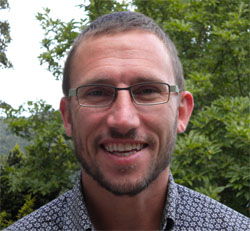 Christophe Detrembleur was born in Verviers (Belgium) in 1974 and he studied chemistry at the University of Liège (Belgium). In March 2001, he obtained his PhD under the supervision of Prof. Robert Jérôme at the Center for Education and Research on Macromolecules (CERM), University of Liège, Belgium. His major research topic was the search for new regulators for the controlled radical polymerisation of (meth)acrylic monomers. In parallel, he also contributed to the development of new functional aliphatic polyesters. He was an invited researcher at IBM, Almaden Research Center, California (USA) under the supervision of Dr. J. Hedrick for three months in 1998. In May 2001, he joined the Research Center of Bayer AG in Leverkusen (Germany), where he worked on materials synthesis and polymer processing. In January 2003, he moved to the polyurethane research division at Bayer, where he was involved in the development of new high performance UV coatings. In October 2003, he was awarded a permanent Research Associate position at CERM under the auspices of the National Fund for Scientific Research (F.R.S.-FNRS). In October 2008, he was promoted Senior Research Associate by the F.R.S.-FNRS and heads a research team at CERM. His main research projects are in the field of new controlled radical polymerisation techniques, preparation of new polymeric materials by these techniques, and contribution of macromolecular engineering to nanotechnology.
Christophe Detrembleur was born in Verviers (Belgium) in 1974 and he studied chemistry at the University of Liège (Belgium). In March 2001, he obtained his PhD under the supervision of Prof. Robert Jérôme at the Center for Education and Research on Macromolecules (CERM), University of Liège, Belgium. His major research topic was the search for new regulators for the controlled radical polymerisation of (meth)acrylic monomers. In parallel, he also contributed to the development of new functional aliphatic polyesters. He was an invited researcher at IBM, Almaden Research Center, California (USA) under the supervision of Dr. J. Hedrick for three months in 1998. In May 2001, he joined the Research Center of Bayer AG in Leverkusen (Germany), where he worked on materials synthesis and polymer processing. In January 2003, he moved to the polyurethane research division at Bayer, where he was involved in the development of new high performance UV coatings. In October 2003, he was awarded a permanent Research Associate position at CERM under the auspices of the National Fund for Scientific Research (F.R.S.-FNRS). In October 2008, he was promoted Senior Research Associate by the F.R.S.-FNRS and heads a research team at CERM. His main research projects are in the field of new controlled radical polymerisation techniques, preparation of new polymeric materials by these techniques, and contribution of macromolecular engineering to nanotechnology.
Please follow the link for further information on Christophe Detrembleur’s scientific production and his recent paper in Polymer Chemistry.
What was your inspiration in becoming a chemist?
I have always been interested in sciences. Fortunately I got a very good chemistry teacher at school who sparked my interest in organic chemistry. It was for me really fascinating to write chemical reactions on a piece of paper and then to build new structures in the lab by mixing molecules in a suitable way. I love(d) reactions that are(were) fuming and that change(d) color!
What was the motivation behind the research in your recent Polymer Chemistry paper? (DOI: 10.1039/c1py00198a)
My research activities have two main facets: (1) developing new tools for the macromolecular engineering mainly by searching for novel ways for controlling the radical polymerizations of difficult monomers, and (2) using the living/controlled polymerization techniques (home-made or not) for designing (nano)materials for advanced applications. The paper published in Polymer Chemistry belongs to the second category and originates from a fruitful collaboration between 6 complementary research teams. Our aim was to combine our different expertise to design new non-toxic MRI contrast agents of high interest in diagnostics. This article combines therefore polymer syntheses, polymer modifications, cytotoxicity tests, relaxometry measurements and CH50 tests (to evaluate the immune response after product injection). Some of our optimized products are actually being tested further… waiting for the results!!
Why did you choose Polymer Chemistry to publish your work?
Although it is a new journal, Polymer Chemistry is already a reference and is well-established in the polymer community. Most of the published articles are of high quality. There is no doubt for me that this journal will be amongst the most important ones in the polymer field. We submitted our article on invitation but we already published several in this journal…and others are in the pipeline!
In which upcoming conferences may our readers meet you?
I will take part in the ACS fall meeting in Denver (USA) at the end of August. I am actually looking for two post-docs. I invite interested candidates that will participate in this meeting to meet me there (session on Controlled Radical Polymerization).
How do you spend your spare time?
Mountain-biking, playing with my son with video games, fishing and home renovation.
Which profession would you choose if you were not a scientist?
Fighter pilot.










